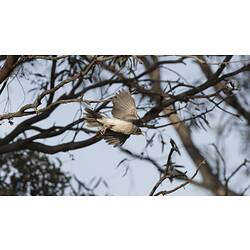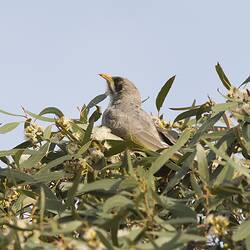General Description
A medium-sized, solid honeyeater. Grey above and on the breast with a white rump and belly. Tail and wings are grey with a yellow flush. Distinct yellow flush on the side of the neck and a yellow forehead. Black face surrounding a bright yellow eye patch. Yellow bill and legs. Body size is 25 to 27 cm.
Biology
Yellow-throated Miners often hang out in family groups, which occupy and defend a territory. They can be quite noisy and aggressive at times, ganging up on other birds and driving them out of their territory. They are not afraid to take on much bigger birds such as eagles, crows and owls and their alarm calls can indicate the presence of snakes, goannas, cats and other predators. Their calls are often strident and harsh, but they also have a musical song often issued pre-dawn. They feed on nectar, fruits, and insects, and build a deep cup nest of grass and twigs, lined with soft materials, in the fork of a tree or shrub. They lay 3 or 4 pinkish eggs spotted and blotched with reds and browns.
Distribution
Across Australia.
Habitat
Dry open woodlands and shrublands.
More Information
-
Animal Type
-
Animal SubType
-
Brief Id
A solid-built honeyeater with a grey body, white rump, yellow throat patch, black face and yellow eye patch and bill.
-
Colours
Green, Grey, Yellow
-
Maximum Size
28 cm
-
Habitats
-
Diet
Omnivore
-
Endemicity
-
Commercial
No
-
Conservation Statuses
CITES: Not listed, FFG Threatened List: Not listed, EPBC Act 1999: Not listed, IUCN Red List: Least Concern
-
Taxon Name
-
Common Name
Yellow-throated Miner
-
Other Names
White-rumped Miner , Micky
-
Kingdom
-
Phylum
-
Subphylum
-
Class
-
Order
-
Family
-
Genus
-
Species Name
flavigula




















